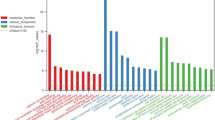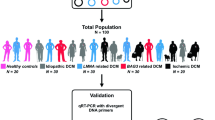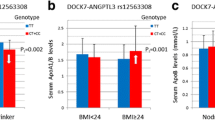Abstract
The aim of our study was to investigate the potential association of mRNA expression and plasma levels of the LIM domain 7 (LMO7) gene with the pathogenesis of dilated cardiomyopathy (DCM). Two SNPs of the LMO7 gene were genotyped in 310 patients with DCM and 415 controls. Our results showed that SNP rs7986131 (p = 0.002, OR = 1.38, 95% CI = 1.12–1.71), but not SNP rs4884021, was associated with DCM in the Han Chinese population. Haplotype analysis showed that the haplotype GT was associated with increased DCM susceptibility while AC was a protective haplotype. The Cox multivariate survival analysis indicated that the rs7986131 TT genotype (HR 1.659, 95% CI = 1.122–2.454, p = 0.011) was an independent multivariate predictor for shorter overall survival in patients with DCM. LMO7 mRNA expression and plasma LMO7 levels were significantly decreased in DCM (p < 0.0001). Spearman correlation test revealed that the plasma LMO7 level was negatively associated with left ventricular end-diastolic diameter (r = −0.384, p = 0.01), left ventricular end-diastolic volume (r = −0.375, p = 0.012), and brain natriuretic peptide (r = −0.482, p = 0.001). Our study suggested that the LMO7 gene may play an important role in the pathogenesis of DCM in the Han Chinese population.




Similar content being viewed by others
References
Givertz, M. M., & Mann, D. L. (2013). Epidemiology and natural history of recovery of left ventricular function in recent onset dilated cardiomyopathies. Current Heart Failure Reports, 10, 321–330.
Towbin, J. A., & Bowles, N. E. (2002). The failing heart. Nature, 415, 227–233.
Elliott, P., et al. (2008). Classification of the cardiomyopathies: a position statement from the European Society of Cardiology Working Group on Myocardial and Pericardial Diseases. European Heart Journal, 29, 270–276.
Watkins, H., Ashrafian, H., & Redwood, C. (2011). Inherited cardiomyopathies. The New England Journal of Medicine, 364, 1643–1656.
Towbin, J. A. (2014). Inherited cardiomyopathies. Circulation Journal, 78, 2347–2356.
Hazebroek, M., Dennert, R., & Heymans, S. (2012). Diopathic dilated cardiomyopathy: possible triggers and treatment strategies. Netherlands Heart Journal, 20(332–5).
Tsirka, A. E., et al. (2004). Improved outcomes of pediatric dilated cardiomyopathy with utilization of heart transplantation. Journal of the American College of Cardiology, 44, 391–397.
Jefferies, J. L., & Towbin, J. A. (2010). Dilated cardiomyopathy. Lancet, 375, 752–762.
Felker, G. M., et al. (2000). Underlying causes and long-term survival in patients with initially unexplained cardiomyopathy. The New England Journal of Medicine, 342, 1077–1084.
Weekes, J., et al. (2003). Hyperubiquitination of proteins in dilated cardiomyopathy. Proteomics, 3, 208–216.
Müller, A. L., & Dhalla, N. S. (2012). Role of various proteases in cardiac remodeling and progression of heart failure. Heart Failure Reviews, 17, 395–409.
Birks, E. J., et al. (2008). Elevated p53 expression is associated with dysregulation of the ubiquitin-proteasome system in dilated cardiomyopathy. Cardiovascular Research, 79, 472–480.
Biesbroek, P. S., Beek, A. M., Germans, T., Niessen, H. W., & van Rossum, A. C. (2015). Diagnosis of myocarditis: current state and future perspectives. International Journal of Cardiology, 15, 211–219.
Margossian, S. S., et al. (1999). Calcium regulation in the human myocardium affected by dilated cardiomyopathy: a structural basis for impaired Ca2+-sensitivity. Molecular and Cellular Biochemistry, 194, 301–313.
Semenova, E., Wang, X., Jablonski, M. M., Levorse, J., & Tilghman, S. M. (2003). An engineered 800 kilobase deletion of Uchl3 and Lmo7 on mouse chromosome 14 causes defects in viability, postnatal growth and degeneration of muscle and retina. Human Molecular Genetics, 12, 1301–1312.
Holaska, J. M., Rais-Bahrami, S., & Wilson, K. L. (2006). Lmo7 is an emerin-binding protein that regulates the transcription of emerin and many other muscle-relevant genes. Human Molecular Genetics, 15, 3459–3472.
Dedeic, Z., Cetera, M., Cohen, T. V., & Holaska, J. M. (2011). Emerin inhibits Lmo7 binding to the Pax3 and MyoD promoters and expression of myoblast proliferation genes. Journal of Cell Science, 124, 1691–1702.
Bradfield, J. P., et al. (2011). A genome-wide meta-analysis of six type 1 diabetes cohorts identifies multiple associated loci. PLoS Genetics, 7, e1002293. doi:10.1371/journal.pgen.1002293.
Koch, A. J., & Holaska, J. M. (2014). Emerin in health and disease. Seminars in Cell & Developmental Biology, 29, 95–106.
Richardson, P., et al. (1996). Report of the 1995 World Health Organization/International Society and Federation of Cardiology Task Force on the Definition and Classification of cardiomyopathies. Circulation, 93, 841–884.
Maron, B. J., et al. (2006). Contemporary definitions and classification of the cardiomyopathies an American heart association scientific statement from the council on clinical cardiology, heart failure and transplantation committee; quality of care and outcomes research and functional genomics and translational biology interdisciplinary working groups; and council on epidemiology and prevention. Circulation, 113, 1807–1816.
Sole, X., Guino, E., Valls, J., Iniesta, R., & Moreno, V. (2006). SNPStats: a web tool for the analysis of association studies. Bioinformatics, 22, 1928–1929.
Murray, A. (1995). Cyclin ubiquitination: the destructive end of mitosis. Cell, 81, 149–152.
Mizukami-Murata, S., Iwahashi, H., Kimura, S., Nojima, K., Sakurai, Y., Saitou, T., Fujii, N., et al. (2010). Genome-wide expression changes in Saccharomyces cerevisiae in response to high-LET ionizing radiation. Applied Biochemistry and Biotechnology, 162, 855–870.
Cardoso, F., Ross, J. S., Picart, M. J., Sotiriou, C., & Durbecq, V. (2004). Targeting the ubiquitin-proteasome pathway in breast cancer. Clinical Breast Cancer, 5, 148–157.
Kostin, S., et al. (2003). Myocytes die by multiple mechanisms in failing human heart. Circulation Research, 92, 715–724.
Leck, S. H., Solomon, V., Price, S. R., Kwon, Y. T., Mitch, W. E., & Goldberg, A. L. (1999). Ubiquitin conjugation by the N end rule pathway and mRNAs for its components increase in muscles of diabetic rats. The Journal of Clinical Investigation, 104, 1411–1420.
Bodine, S. C., et al. (2001). Identification of ubiquitin ligases required for skeletal muscle atrophy. Science, 294, 1704–1708.
Gomes, M. D., Lecker, S. H., Jagoe, R. T., Navon, A., & Goldberg, A. L. (2001). Atrogin-1, a muscle-specific F-box protein highly expressed during muscle atrophy. Proceedings of the National Academy of Sciences of the United States of America, 98, 14440–14445.
Tintignac, L. A., et al. (2005). Degradation of MyoD mediated by the SCF (MAFbx) ubiquitin ligase. The Journal of Biological Chemistry, 280, 2847–2856.
Mearini, G., Schlossarek, S., Willis, M. S., & Carrier, L. (2008). The ubiquitin–proteasome system in cardiac dysfunction. Biochimica et Biophysica Acta, 1782, 749–763.
Rozenblum, E., et al. (2002). A genomic map of a 6-Mb region at 13q21-q22 implicated in cancer development: identification and characterization of candidate genes. Human Genetics, 110, 111–121.
Murphy, A. M., et al. (2000). Transgenic mouse model of stunned myocardium. Science, 287, 488–491.
Liu, G., Cheng, Y., Zhao, W., Jin, Z., Shan, H., & Xu, G. (2011). Single-base extension and ELISA-based approach for single-nucleotide polymorphisms genotyping. Applied Biochemistry and Biotechnology, 163, 573–576.
Rezk, N. A., Zidan, H. E., Elnaggar, Y. A., & Ghorab, A. (2015). Renalase gene polymorphism and epinephrine level in chronic kidney disease. Applied Biochemistry and Biotechnology, 175, 2309–2317.
Cowell, J. K., & Bia, B. A. (1998). Novel missense mutation in patients from a retinoblastoma pedigree showing only mild expression of the tumor phenotype. Oncogene, 16, 3211–3213.
Pashmforoush, M., et al. (2001). Adult mice deficient in actinin-associated LIM-domain protein reveal a developmental pathway for right ventricular cardiomyopathy. Nature Medicine, 7, 591–597.
Krause, A., et al. (2004). Tbx5 and Tbx4 transcription factors interact with a new chicken PDZ-LIM protein in limb and heart development. Developmental Biology, 273, 106–120.
Ott, E. B., et al. (2008). The lim domain only protein 7 is important in zebrafish heart development. Developmental Dynamics, 237, 3940–3952.
Mewborn, S. K., et al. (2010). Altered chromosomal positioning, compaction, and gene expression with a lamin A/C gene mutation. PloS One, 5, e14342. doi:10.1371/journal.pone.0014342.
Day, S. M. (2013). The ubiquitin proteasome system in human cardiomyopathies and heart failure. American Journal of Physiology. Heart and Circulatory Physiology, 304, H1283–H1293.
Baar, K., Nader, G., & Bodine, S. (2006). Resistance exercise, muscle loading/unloading and the control of muscle mass. Essays in Biochemistry, 42, 61–74.
Acknowledgements
This work was supported by the National Natural Science Foundation of China (No. 81270289 and 81300170), the Funds for International Cooperation and Exchange of Sichuan Province (No. 2012HH0032), and the Specialized Research Fund for the Doctoral Program of Higher Education of China (No. 20110181110011).
Author Contributions
Li Rao conceived and designed the experiments; WenJuan Bai and ChunMei Li collected clinical data; ChunMei Li, Ying Peng, and Bin Zhou performed the experiments; ChunMei Li analyzed the data; ChunMei Li contributed reagents, materials, and analysis tools; ChunMei Li wrote the paper.
Author information
Authors and Affiliations
Corresponding author
Ethics declarations
The study was approved by the hospital Ethics Committee. The methods were carried out in accordance with the relevant guidelines, including any relevant details. Written informed consent was obtained from all participants.
Conflict of Interest
The authors declare that they have no conflict of interest.
Additional information
ChunMei Li and Ying Peng contributed equally.
Electronic Supplementary Material
ESM 1
(DOC 37 kb)
Rights and permissions
About this article
Cite this article
Li, C., Peng, Y., Zhou, B. et al. Association of LIM Domain 7 Gene Polymorphisms and Plasma Levels of LIM Domain 7 with Dilated Cardiomyopathy in a Chinese Population. Appl Biochem Biotechnol 182, 885–897 (2017). https://doi.org/10.1007/s12010-016-2368-1
Received:
Accepted:
Published:
Issue Date:
DOI: https://doi.org/10.1007/s12010-016-2368-1




